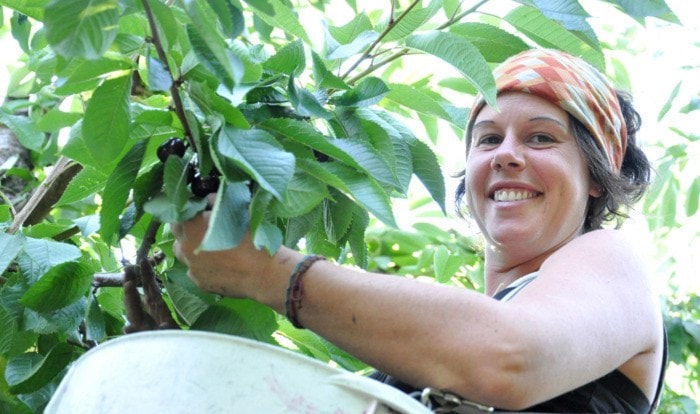Creston cherry grower Jenny Faynor said the 2012 late-season cherry harvest has its challenges but, compared to recent years, “it’s a big crop that ranges in quality from pretty good to very good.”
Faynor, with her husband, Rick, has about 36 acres of cherries in production. They operate their own sorting and packing facility, hiring about 50 local residents to sort, pack and weigh Lapin, Staccato and Sweetheart varieties for distribution to retailers in Asia, Europe and even Florida.
“Actually, this crop is exceptional compared to the last few years,” she said on Tuesday. “We aren’t dealing with the damage that was so high in the last few crops.”
While a cool, wet spring and early summer caused some inconsistency in the size of cherries in each cluster, the last month of hot dry weather helped grow and ripen the fruit. The heat has caused some of the fruit to be soft, making it unworthy of shipment to international markets.
“We really rely on our sorters to make sure only firm cherries end up in the shipments,” she said. “They are really working hard this year and they make a huge difference in how our cherries are accepted on the market. If we ship fruit that doesn’t last, costs skyrocket because we have already paid to have it picked, packed and shipped. Rejections at the receiving end really hurt.”

Faynor said the harvest started slowly when many of the pickers they had hired didn’t show up as expected.
“I think some thought that because the South Okanagan has had such a bad season that we would be in the same boat,” she said. “But we’re running at a really high pace now.”
While at least one local grower has declared the Lapin cherry market to be over for local growers because of the huge production in Washington, Faynor said she believes the key is to have a mix of varieties.
“All in all we’ve been really happy with this harvest — we are just finishing up the Lapin harvest and picking Sweethearts could start as early as Wednesday this week. The Staccatos will be ready about six days later.”
Although wholesale prices for late season cherries is far lower than they were a decade ago, Faynor says that local fruit broker Andre Bailey “does a fantastic job for us — he really cares about the growers.”
Bailey, who operates Global Fruit, works to find buyers around the world for B.C. products.
“Prices started lower than last year, but that’s not unusual,” she said. “They usually pick up as the harvest goes on. Generally, a quality pack means a fairly decent price.
If we send garbage out, it gets rejected at the other end and then that has an impact on future sales — I can’t emphasize enough that shipping a quality product that won’t go bad in storage and shipping is the key to our success.”
Sorting for size and quality at the Faynors’ packing facility is a hands-on job, unlike some large, high tech facilities that rely more on electronic sensors.
“It’s critical for our sorters to pull any soft fruit off the table,” she said.
At the Faynors’ facility, freshly picked fruit is dumped into cold water so that it is quickly chilled. Cherries move along a conveyor belt and banks of sorters seated on each side of several tables cull fruit with flaws or without stems. They are trained to recognize soft fruit and to remove it, too.
She estimates that the amount of fruit arriving from the orchards is nearly double what it was in recent years, when heavy rains on ripe fruit caused severe splitting.
While Faynor admits Lapins have been “a hard sell” this year, due to a large crop coming out of Washington, “which is harvesting later and later”, she says Creston Valley cherries are still well received in the market.
“Asians, especially, love Sweethearts and Staccatos — they have such a beautiful deep red colour and are really firm.”
On Tuesday, after a month of hot sunny weather without rain, the forecast changed to the possibility of thunderstorms.
“This is the latest in a long time that we’ve gone without using helicopters,” she said.
Rain and ripe cherries are a bad combination for growers. The fruit absorbs the moisture, causing the skins to split. The result is a cherry destined for the landfill or to be used as compost fertilizer among the trees.
Faynors, like most local growers, have huge fans that attach to tractors as their first line of defense after a rain. Tractors are driven between the rows of trees, the fans shaking free the drops of water that collect on the cherries. Helicopters are also commonly used, with the aircraft rotors acting as fans as the machines fly just above the treetops.
“This year is no different than any other when it comes to rain,” she said. “We will just hope and pray that the rain passes us by. And if it doesn’t we’ll deal with it.”
